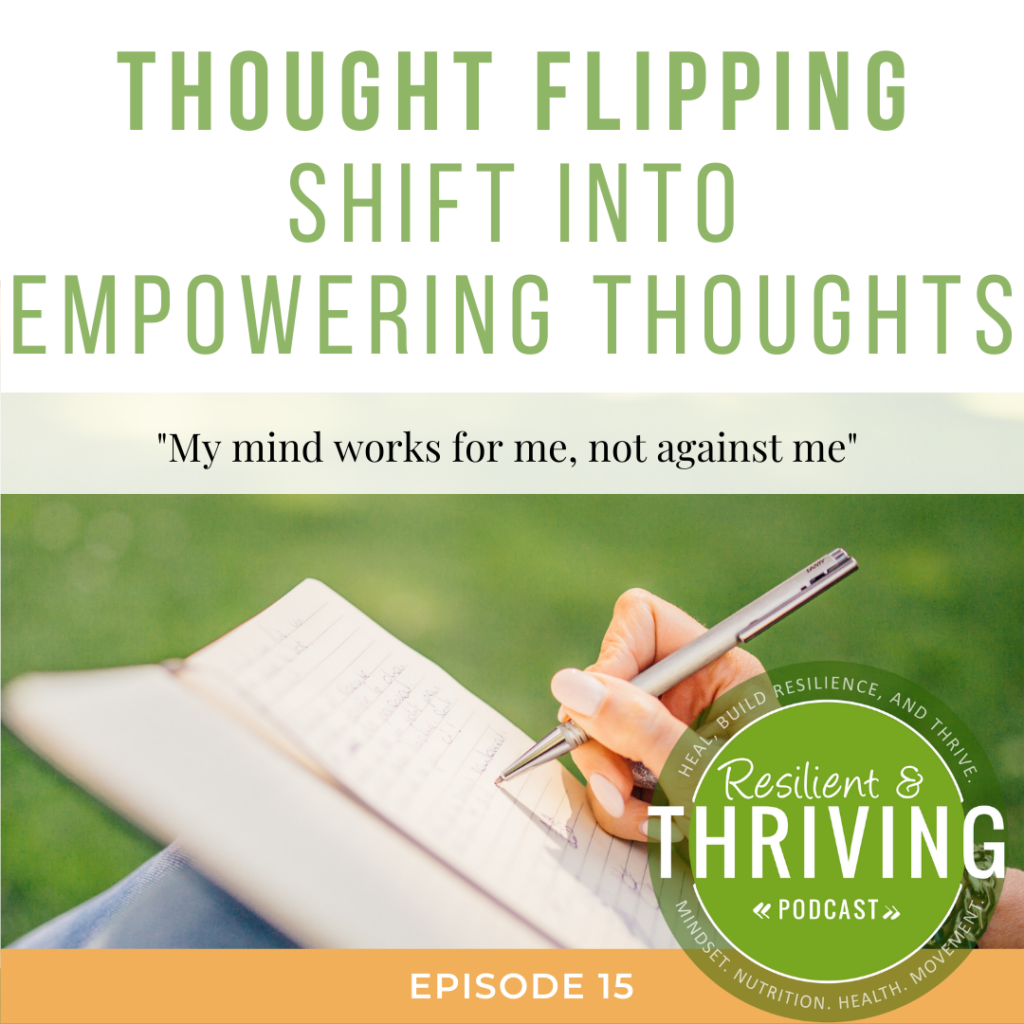Intentional Thought Flipping – EPISODE 15

Thought Flipping: Intentional Effort To Rework Our Thought Processes
If you’ve ever found yourself caught in a cycle of negative thinking, it can be tough to escape it. Negative thinking can be a consuming process–one bad thought can lead to another, and another, until eventually you feel miserable and hopeless in a spiral of negative “what-if” possibilities.
With some practice, you can learn to escape this cycle of negative thought processes through a method called thought flipping.
What is thought flipping?
Thought flipping is a method used to stop negative thinking in its tracks.
To practice thought flipping, you simply follow this pattern:
- Freeflow write out all your current thoughts about something. It can be a brain dump style (freeflow paragraphs) OR a list of specific thoughts.
- Identify negative or bad thoughts once you’ve become aware of them. Purposely “label” it for what it is–you can even say out loud, “That was a negative thought!”
- Take that thought and consider the reasons why it is harmful, unreasonable, or unlikely. Often, negative thoughts are fueled by worry or stress, meaning our minds distort them to unlikely proportions.
- Lastly, flip your negative thought to a more positive (or more likely) thought. If you can’t get fully positive, start with even a neutral thought to begin shifting the atmosphere inside your brain.
- And if you’d like an extra bonus, try and find evidence of these new, empowering thoughts. This will take you to a whole new level!
Here is an example of what thought flipping can look like:
- Mario has been trying to lose weight, but he’s struggling to stick to his plan 100% and isn’t seeing the results he hoped for by now. He thinks to himself, “I am never going to be able to do this, so I should just give up.” This is Mario’s initial negative and harmful thought process.
- Mario realizes he’s just had a negative thought. To solidify this fact, he tells himself, “Wow…. I was being really negative about this situation by thinking that way.”
- Mario flips his thought to be more truthful and positive by saying, “I have already made some good and healthy changes on my weight loss journey, so I am going to keep trying and moving along.”
Why is it easier to have negative thoughts rather than positive ones?
Overall, human beings tend to think more negatively than positively. Why are we like this? Science has an answer!
Humans have an internal inclination called a negativity bias, meaning we often find it easier to be negative rather than positive. Believe it or not, this negativity bias is responsible for some good features.
For example, because of our negativity biases, we remember tragic, painful, or frightening events with ease. These memories make us approach dangerous situations more cautiously because they make us remember what it feels like to get hurt, feel scared, or have an otherwise negative experience.
The first time you touched a hot stove left a permanent, deep memory in your mind. As an adult, you take great care to avoid touching the stove because you remember clearly what a bad burn feels like.
In this case, having a negativity bias is a good thing because it serves as a tool for survival. However, it can often get in the way of really amazing opportunities. If you spend more time considering negative outcomes and possible failures, you let your negativity bias take control in situations where it doesn’t belong.
For example, if you let a fear of failure stop yourself from leaving your miserable job, you won’t ever find a new and better one.
How can I practice thought flipping?
If you have a particularly strong inclination toward negative thinking, it can take quite a bit of practice to really master the art of thought flipping.
Begin by identifying one or two of your most common, recurring negative thoughts to “flip.”
After you’ve developed a strong sense of flipping these one or two thoughts, expand your efforts toward other negative thoughts you have.
I like to even do a brain dump:
Write out ALL the limiting beliefs I’m thinking right now in one column.
Then write out an empowering thought in the right column for every negative thought.
Begin declaring, meditating on, visualizing and listening to these new thoughts.
Need some help getting started? Download my FREE Affirmations workbook to learn to grow in transforming your mindset.

Hi there! My name is Kirsten Larsen, also known as Coack K. I’m a holistic health coach, Clinical EFT practitioner, and running coach. My journey has been a long one in the way of healing my body, emotional healing, trauma healing, transformational mindset techniques, emotional freedom technique, learning nutrition, injury prevention, running form and technique, and more. All in all, what I’ve found is that we are designed to thrive in our body, soul, and spirit. If we are not, then there is simply an element we’re missing. It’s been my passion and joy to help people remove the blocks that keep them from thriving in their body and mind, so that they can thrive in life. If you’re interested in coaching, sign up for a free consultation call here.

